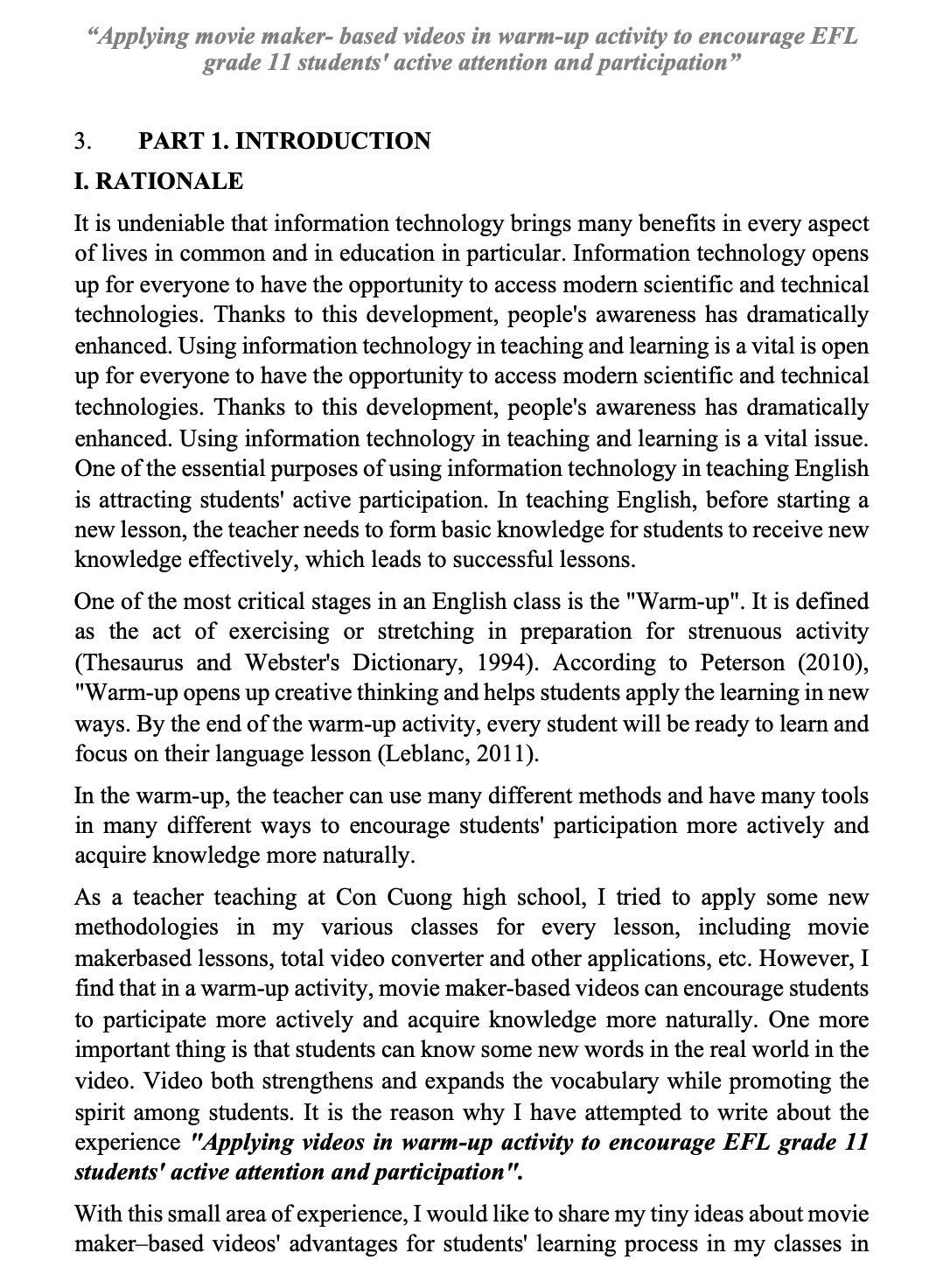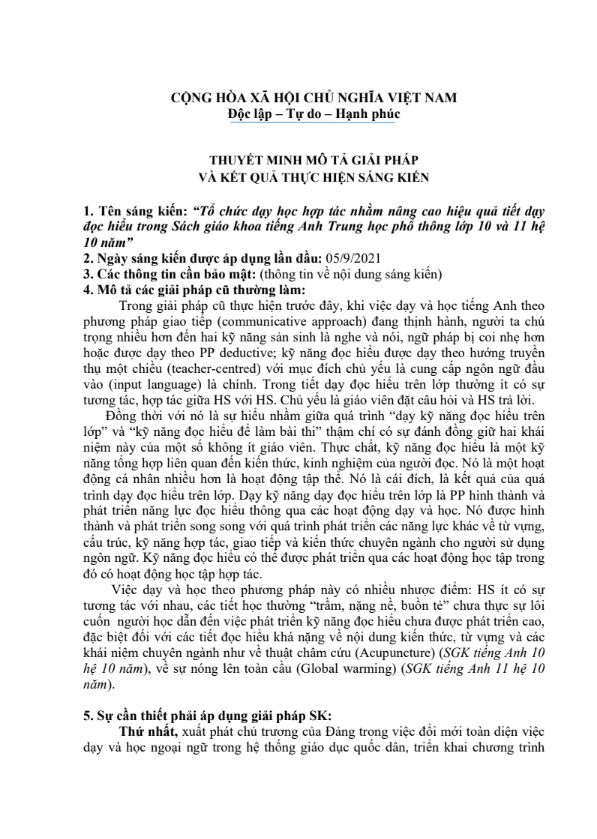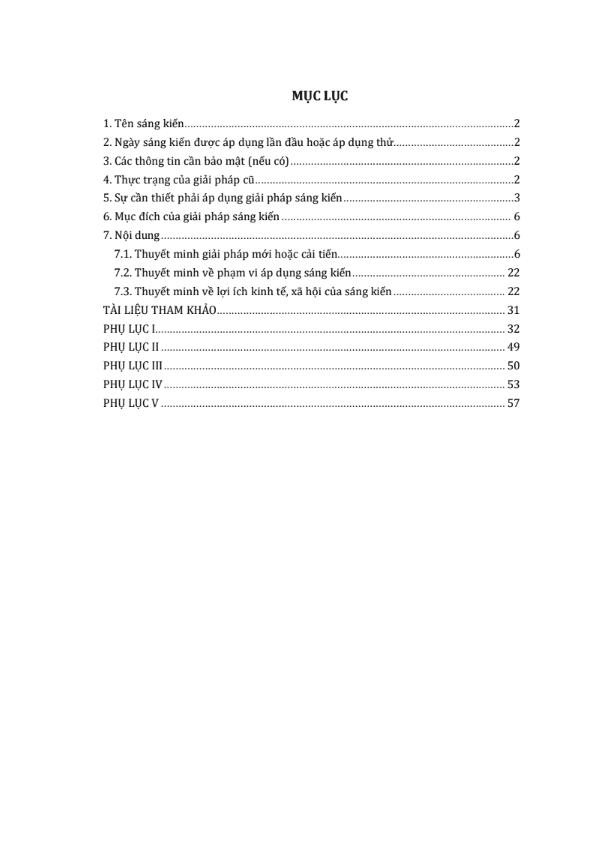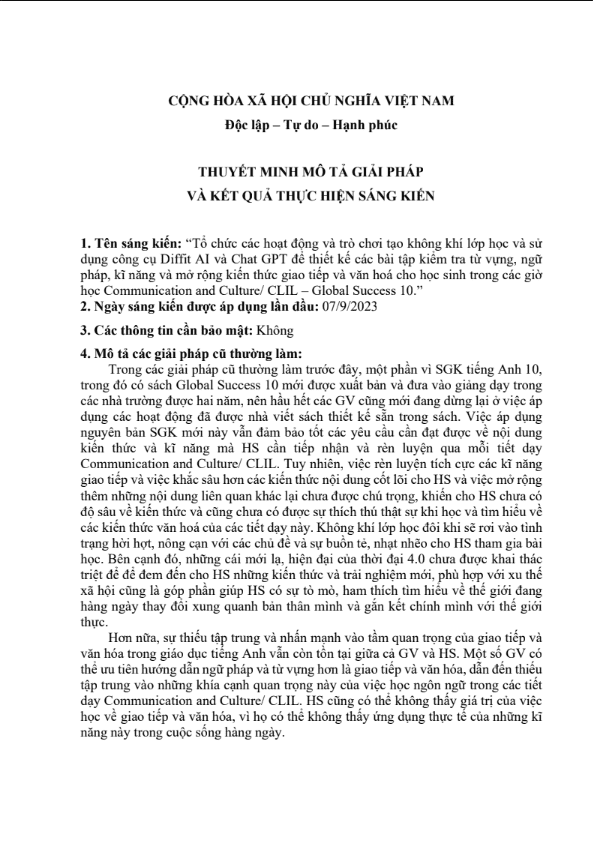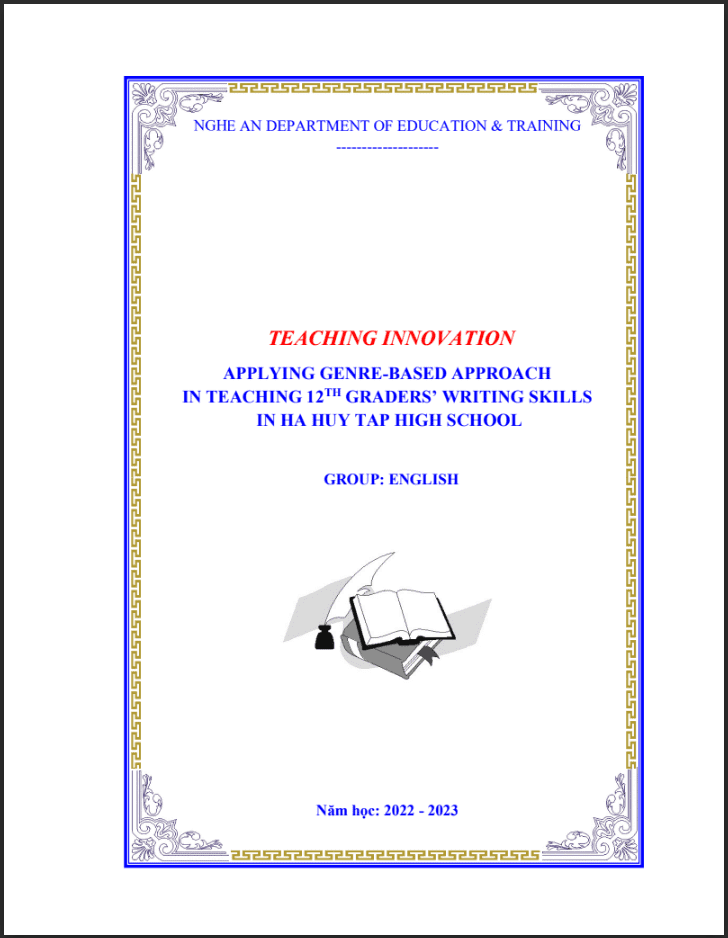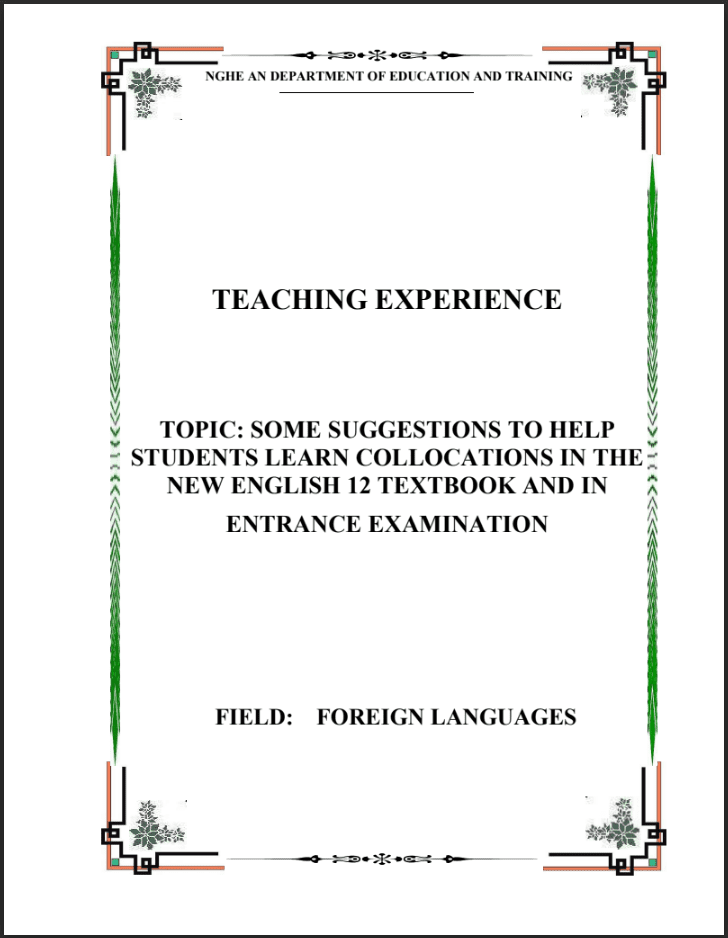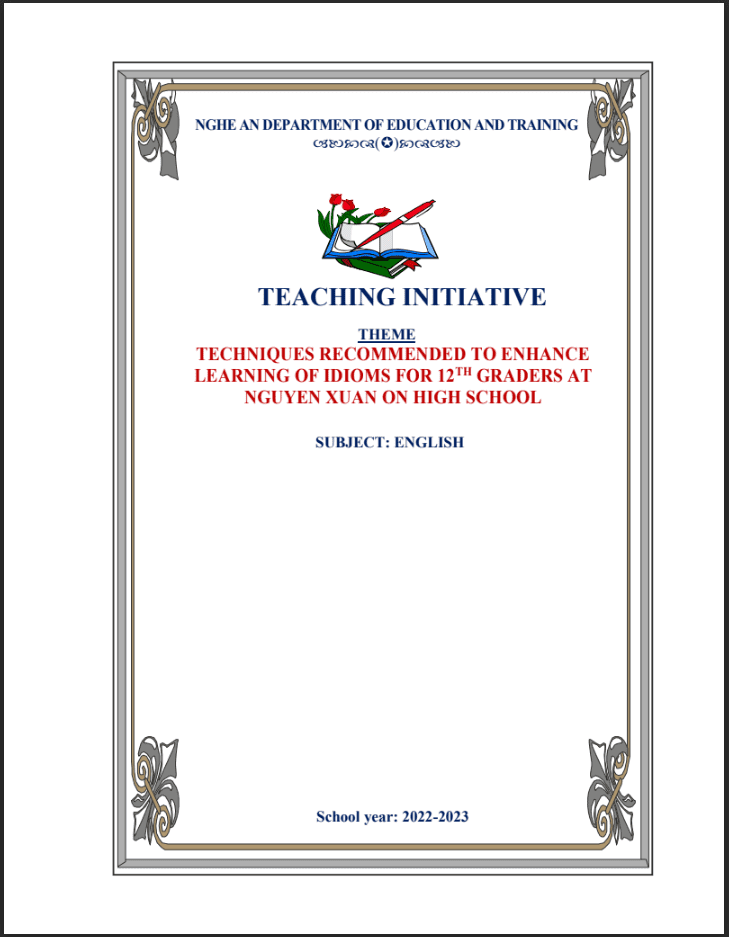SKKN Applying movie maker- based videos in warm-up activity to encourage EFL grade 11 students’ active attention and participation
- Mã tài liệu: MP0037 Copy
| Môn: | Tiếng anh |
| Lớp: | 11 |
| Bộ sách: | |
| Lượt xem: | 1275 |
| Lượt tải: | 9 |
| Số trang: | 36 |
| Tác giả: | Trần Thị Hương |
| Trình độ chuyên môn: | Cử nhân đại học |
| Đơn vị công tác: | THPT Diễn Châu 4 |
| Năm viết: | 2021-2022 |
| Số trang: | 36 |
| Tác giả: | Trần Thị Hương |
| Trình độ chuyên môn: | Cử nhân đại học |
| Đơn vị công tác: | THPT Diễn Châu 4 |
| Năm viết: | 2021-2022 |
Sáng kiến kinh nghiệm “SKKN Applying movie maker- based videos in warm-up activity to encourage EFL grade 11 students’ active attention and participation” triển khai gồm các biện pháp nổi bật sau:
– a teacher who displays interest and positive feelings about a subject can reflect those positive feelings toward students, thus increasing their motivation to learn the subject
– should encourage students to work and help their partners to improve together.
– Teacher often do this through their support for students’ autonomy
Mô tả sản phẩm
I. RATIONALE
It is undeniable that information technology brings many benefits in every aspect of lives in common and in education in particular. Information technology opens up for everyone to have the opportunity to access modern scientific and technical technologies. Thanks to this development, people’s awareness has dramatically enhanced. Using information technology in teaching and learning is a vital is open up for everyone to have the opportunity to access modern scientific and technical technologies. Thanks to this development, people’s awareness has dramatically enhanced. Using information technology in teaching and learning is a vital issue. One of the essential purposes of using information technology in teaching English is attracting students’ active participation. In teaching English, before starting a new lesson, the teacher needs to form basic knowledge for students to receive new knowledge effectively, which leads to successful lessons.
One of the most critical stages in an English class is the “Warm-up”. It is defined as the act of exercising or stretching in preparation for strenuous activity (Thesaurus and Webster’s Dictionary, 1994). According to Peterson (2010), “Warm-up opens up creative thinking and helps students apply the learning in new ways. By the end of the warm-up activity, every student will be ready to learn and focus on their language lesson (Leblanc, 2011).
In the warm-up, the teacher can use many different methods and have many tools in many different ways to encourage students’ participation more actively and acquire knowledge more naturally.
As a teacher teaching at Con Cuong high school, I tried to apply some new methodologies in my various classes for every lesson, including movie makerbased lessons, total video converter and other applications, etc. However, I find that in a warm-up activity, movie maker-based videos can encourage students to participate more actively and acquire knowledge more naturally. One more important thing is that students can know some new words in the real world in the video. Video both strengthens and expands the vocabulary while promoting the spirit among students. It is the reason why I have attempted to write about the experience “Applying videos in warm-up activity to encourage EFL grade 11 students’ active attention and participation”.
With this small area of experience, I would like to share my tiny ideas about movie maker–based videos’ advantages for students’ learning process in my classes in the background and investigate the students’ active attention and participation as well.
II. THE IMPROVEMENT OF THE THEME
The idea of applying movie maker-based videos in the teaching and learning process has attracted the considerable interest of many educators and teachers worldwide. However, in Vietnam, the exploitation of movie maker-based videos’ potential in lessons seems to be very limited, particularly in mountainous areas like mine. To the present, movie maker-based videos seem to be one of the most effective solutions for teaching, especially in warm-up activities to attract students’ active attention and participation.
III. THE PURPOSE OF THE THEME
When writing this experience, The teacher desires to add a few of my opinions on issues related to using on movie maker- based videos in warm-up activities during English class to make the lesson more effective and engage students’ active attention and participation.
IV. THE OBJECTS AND SCOPE OF THE THEME
- The objectives of the theme
- This study focuses on researching methods of teaching Warm-up for Con Cuong high school students.
- Subjects of the study are students in grades 11
- The scope of the theme
- This study is concerned with using movie maker-based videos in warm up activities in English 11.
- The research was conducted in the classrooms of Con Cuong high school during the year 2021-2022.
V. METHODOLOGIES
The teacher applies a variety of research methods such as:
- Experimental method
- Methods of investigation and observation.
- Research methods.
- Researching teaching methods through documents, networks, colleagues…
PART 2. CONTENT
I. LITERATURE REVIEW
This part presents a brief review of the literature on the topics typically related to the research in this paper and prior studies on movie-maker-based videos in education generally and in teaching and learning in particular. Moreover, this study will also focus on some issues of involvement and assessments.
1. The definitions
1.1. The Definitions of warm – up activity
Up to the present, the definition of warm-up activity has been differently defined different educationists and other supervisors. According to Leblanc (2011), warm-up activities will help students turn off the outside world and focus on the task. In an English lesson, almost every class has five activities (Warm-up, presentation, practice, and application), and warm-up is the first one. By the end of the warm-up activity, every student will be ready to learn and be able to focus on their language There are always more reticent students willing to let others do all the participating in any classroom. By engaging students to take part in a low-risk, warm-up activity, a teacher will reach every student and help their students achieve their language goals. Flanigan (2011) also explains that warmup activities in English class will help students learn in the right frame of mind. Also, proper warm-up activities ensure that students get the most from their course.
1.2. The Definitions of attention
William James(1890) claims that attention “is the taking possession by the mind, in clear and vivid form, of one out of what may seem several simultaneously possible objects or trains of thought…It implies withdrawal from some things in order to deal effectively with others.”
Attention plays a vital role in the teaching-learning process. Without this, learning cannot be effective. It helps a child to grasp things better. Attention allows people to focus on information to create memories. It also allows people to avoid distractions to focus on and complete specific tasks. John Ratey (2001) also adds that attention is more than just noticing incoming stimuli. It involves several processes, including filtering out perceptions, balancing multiple perceptions, and attaching emotional significance to these perceptions, according to John Ratey (2001).
1.3 The Definitions of Participation
The term ‘participation’ is associated with several related words, such as ‘taking Part,’ ‘involvement,’ and ‘consultation’. Taking the dictionary (e.g., Merriam Webster) definition of the term as a starting point, it is possible to differentiate between two groups of interpretations (1) Participation in ‘taking part in,’ i.e. ‘being present. (2) Participation in the sense of ‘having a part or share in something’ is related to notions such as empowerment and ‘ownership’ and refers to one’s feeling of being taken seriously and able to make an impact.
In the school context, participation is often used to refer to the interactivity of teaching strategies seen as conducive to students’ motivation but without severe consequences for their influence. Similarly, participation sometimes means taking part in a class discussion.
According to Ken Shore(1998), Class participation is an essential aspect of student learning. When students speak up in class, they learn to express their ideas so that others can understand. When they ask questions, they know how to obtain information to enhance their understanding of a topic. Class participation is also a valuable learning tool for teachers. Through students’ questions, you learn what they do not understand and can adjust your instruction accordingly.
According to Weimer (2011), there are many benefits when students participate in class. For instance, participation adds interest to the lesson; it is challenging to maintain students’ attention when they only listen to the teacher. When students participate, it helps them hear another voice or another point of view. Besides, when the students participate, the teacher receives feedback on the lesson; instructors can check the understanding of a topic. As a result, it is possible to help the students correct what they have not got right or do not see quite clearly.
Moreover, participation can encourage creating dialogue among and between students; learners can comment on what another has said, or it can be a pair discussing a specific topic. Thus, participation recreates a crucial role in the learning process.
1.4. The Definitions of Windows Moviemaker application
According to Shaw (2008), Windows Moviemaker is a video editing tool that can capture raw video footage, edit it, and add titles, transitions, and video effects. Windows Movie Maker (known as Windows Live Movie Maker for the 2009 and 2011 releases) is Microsoft’s discontinued video editing software
program. It was a software suite and offered the ability to create and edit videos and publish them on One Drive, Facebook, Vimeo, Youtube.
TÀI LIỆU LIÊN QUAN
- 7
- 105
- 1
- [product_views]
- 5
- 173
- 2
- [product_views]
- 4
- 165
- 3
- [product_views]
- 4
- 129
- 4
- [product_views]
100.000 ₫
- 6
- 434
- 5
- [product_views]
100.000 ₫
- 2
- 507
- 6
- [product_views]
100.000 ₫
- 9
- 546
- 7
- [product_views]
100.000 ₫
- 4
- 409
- 8
- [product_views]
100.000 ₫
- 2
- 595
- 9
- [product_views]
100.000 ₫
- 0
- 538
- 10
- [product_views]

